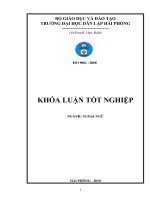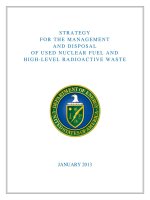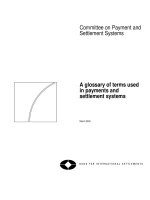used battery collection and recycling
Bạn đang xem bản rút gọn của tài liệu. Xem và tải ngay bản đầy đủ của tài liệu tại đây (21.27 MB, 385 trang )
Industrial Chemistry Library, Volume 10
Used Battery Collection
and Recycling
Industrial Chemistry Library
Advisory Editor:
S.T. Sie,
Faculty of Chemical Technology and Materials Science
Delft University of Technology, Delft, The Netherlands
Volume 1
Volume 2
Volume 3
Volume 4
Volume 5
Volume 6
Volume 7
Volume 8
Volume 9
Volume 10
Progress in C 1 Chemistry in Japan
(Edited by the Research Association for C 1 Chemistry)
Calcium Magnesium Acetate. An Emerging Bulk Chemical for
Environmental Applications
(Edited by D.L. Wise, Y.A. Levendis and M. Metghalchi)
Advances in Organobromine Chemistry I
(Edited by J R. Desmurs and B. G6rard)
Technology of Corn Wet Milling and Associated Processes
(by P.H. B lanchard)
Lithium Batteries. New Materials, Developments and Perspectives
(Edited by G. Pistoia)
Industrial Chemicals. Their Characteristics and Development
(by G. Again)
Advances in Organobromine Chemistry II
(Edited by J R. Desmurs, B. G6rard and M.J. Goldstein)
The Roots of Organic Development
(Edited by J R. Desmurs and S. Ratton)
High Pressure Process Technology: Fundamentals and
Applications
(Edited by A. Bertucco and G. Vetter)
Used Battery Collection and Recycling
(Edited by G. Pistoia, J P. Wiaux and S.P. Wolsky)
Industrial Chemistry Library, Volume 10
Used B attery Collection
and Recycling
Edited by
G. Pistoia
Via G. Scalia 10, 00136 Rome, Italy
J P.
Wiaux
Titalyse S.A., Route des Acacias 54 bis, CH-1227 Carouge, Geneva,
Switserland
S.P. Wolsky
Ansum Enterprises, 1900 Cocoanut Road, Boca Raton, Florida 33432, USA
2001
ELSEVIER
Amsterdam - London - New York - Oxford - Paris - Shannon - Tokyo
ELSEVIER SCIENCE B.V.
Sara Burgerhartstraat 25
P.O. Box 211, 1000 AE Amsterdam, The Netherlands
9 2001 Elsevier Science B.V. All rights reserved.
This work is protected under copyright by Elsevier Science, and the following terms and conditions apply to its
use:
Photocopying
Single photocopies of single chapters may be made for personal use as allowed by national copyright laws.
Permission of the Publisher and payment of a fee is required for all other photocopying, including multiple or
systematic copying, copying for advertising or promotional purposes, resale, and all forms of document delivery.
Special rates are available for educational institutions that wish to make photocopies for non-profit educational
classroom use.
Permissions may be sought directly from Elsevier Science Global Rights Department, PO Box 800, Oxford OX5
1DX, UK; phone: (+44) 1865 843830, fax: (+44) 1865 853333, e-mail: You may also
contact Global Rights directly through Elsevier's home page (), by selecting 'Obtaining
Permissions'.
In the USA, users may clear permissions and make payments through the Copyright Clearance Center, Inc., 222
Rosewood Drive, Danvers, MA 01923, USA; phone: (+1) (978) 7508400, fax: (+1) (978) 7504744, and in the UK
through the Copyright Licensing Agency Rapid Clearance Service (CLARCS), 90 Tottenham Court Road, London
W1P 0LP, UK; phone: (+44) 207 631 5555; fax: (+44) 207 631 5500. Other countries may have a local
reprographic rights agency for payments.
Derivative Works
Tables of contents may be reproduced for internal circulation, but permission of Elsevier Science is required for
external resale or distribution of such material.
Permission of the Publisher is required for all other derivative works, including compilations and translations.
Electronic Storage or Usage
Permission of the Publisher is required to store or use electronically any material contained in this work, including
any chapter or part of a chapter.
Except as outlined above, no part of this work may be reproduced, stored in a retrieval system or transmitted in any
form or by any means, electronic, mechanical, photocopying, recording or otherwise, without prior written
permission of the Publisher.
Address permissions requests to: Elsevier Science Global Rights Department, at the mail, fax and e-mail addresses
noted above.
Notice
No responsibility is assumed by the Publisher for any injury and/or damage to persons or property as a matter of
products liability, negligence or otherwise, or from any use or operation of any methods, products, instructions or
ideas contained in the material herein. Because of rapid advances in the medical sciences, in particular,
independent verification of diagnoses and drug dosages should be made.
First edition 2001
Library of Congress Cataloging in Publication Data
A catalog record from the Library of Congress has been applied for.
ISBN: 0-444-50562-8
~~ The paper used in this publication meets the requirements of ANSI/NISO Z39.48-1992 (Permanence of
Paper).
Printed in The Netherlands.
Preface
About 40 billion batteries were produced in the year 2000 and this number is
increasing at approximately 5% annually. A large number of these batteries
contain hazardous materials. Batteries also contain significant quantities of
important materials. Consequently the uncontrolled disposal of batteries
presents both a major risk to health and the environment and a significant
waste of valuable material resources. Recognizing the importance of
controlling battery waste disposal, worldwide government and industry efforts have
been initiated to collect and recycle such wastes.
Led by the OECD member states, legislation has been put in
place mandating the collection and recycling of cadmium, lead and mercury
batteries. Industry organizations have been established for the purpose of educating
the consumer and developing collection/recycling programs. We may mention the
Portable Rechargeable Battery Association (PRBA) and the Rechargeable Battery
Recycling Corporation (RBRC) in the U.S.A., and the European Portable Battery
Association (EPBA) and CollectNiCad in Europe. As a consequence of these laws
and programs, increasing quantities of spent batteries are being collected and
recycled.
Recycling batteries with their varied chemistries is a difficult task. The success of
the industry in meeting this challenge has been important to the advancement of this
effort.
We wish to express our deep gratitude to the contributors of the various
chapters of this book and to the organizations and companies that have
provided us general information and encouragement. Many of these
groups have also contributed on a regular basis to the annual congresses
organized first in the U.S.A. by one of us (S.P. Wolsky) - Seminar on Battery
Waste Management - and later by others in Europe - Battery Recycling
Congress.
Our goal has been to present in one volume a systematic and updated summary
of the important aspects of the battery waste issue. As such this book will
be of interest to all those working in this important field.
G. Pistoia J P.Wiaux S.P. Wolsky
This Page Intentionally Left Blank
vii
List of Contributors
J. DAVID,
SNAM, 9 rue de la Garenne, F-38074, Saint Quentin Fallavier, France
N. ENGLAND,
The Portable Rechargeable Battery Association,
1000 Parkwood Circle, Atlanta,
GA 30339, U.S.A.
K. FUJIMOTO,
Portable Rechargeable Battery Committee, Battery Association of Japan,
Kikai,
Shinkou Kaikan Building 5F, 3-5-8 Siba-Kouen, Minato-ku, Tokyo 105-0011, Japan
R. JUNGST,
Lithium Battery R&D Department, Sandia National Laboratories, P.O. Box 5800,
Albuquerque, NM87185-0613, U.S.A.
W. McLAUGHLIN,
Solid Team Inc., 148 Limestone, Claremont, CA 91711, U.S.A.
D.G. MILLER,
Toxco Inc., 3200 E. Frontera, Anaheim, CA 92806, U.S.A.
K. L. MONEY, Inmetco, 245 Portersville Road, P.O. Box 720, Ellwood City, PA 16117, U.S.A.
H. MORROW,
International Cadmium Association,
9222 Jeffery Road, P.O. Box 924, Great
Falls, VA 22066-0924, U.S.A.
E. PAOLUCCI,
Texeco, Via Pomarico 58, 00178 Rome, Italy
A. PESCETELLI,
Texeco, Via Pomarico 58, 00178 Rome, Italy
A. TINE',
Texeco, Via Pomarico 58, 00178 Rome, Italy
N. WATSON,
EPBA, Hazelwick Avenue, Crawley, Mallory House, West Sussex RH 10 1FQ,
Great Britain
D.B. WEINBERG,
Howrey
Simon Arnold
& White, 1299 Pennsylvania Avenue, Washington,
D.C. 20004, U.S.A.
J P. WIAUX,
Titalyse SA, 54bis Route des Acacias, CH-1227 Carouge, Geneva, Switzerland
This Page Intentionally Left Blank
Table of Contents
Preface
List of Contributors
Chapter 1.
Environmental and Human Health Impact Assessments of
Battery Systems 1
H. Morrow
Abstract 1
Introduction 2
Battery Raw Materials Production 5
Manufacture of Battery Systems 10
Use and Maintenance of Battery Systems 15
Disposal of Spent Batteries 17
Environmental and Human Health Impact Assessments 22
Cycle Life Analysis of Battery Systems 26
Conclusions 31
References 32
Chapter 2. Portable Rechargeable Batteries in Europe: Sales,
Uses, Hoarding, Collection and Recycling
35
J P. Wiaux
Introduction 35
The European Market of Portable Rechargeable Batteries 39
Hoarding of Portable Rechargeable Batteries 43
Batteries in Municipal Solid Waste (MSW) 61
Collection of Spent Rechargeable Batteries 66
Collection Efficiency and Recycling Rate 76
Conclusions 81
References 83
Chapter
3. Battery Collection and Recycling in Japan 87
K. Fujimoto
Introduction 87
Treatment of Spent Primary Dry Cells 88
Recycling of Spent Lead-Acid Batteries 91
Collection and Recycling Activities for Portable Rechargeable
Batteries 94
Chapter 4.
Ni-Cd Battery Collection and Recycling Programs in the U.S.A.
and Canada 105
N. England, D.B. Weinberg, K.L. Money and H. Morrow
Introduction
105
The environmental issues 106
The NiCd Battery Recycling Problem
108
The Industry NiCd Battery Recycling Program
109
The INMETCO NiCd Battery Recycling Process
113
Chapter 5.
Environmentally Sound Recycling of Ni-Cd Batteries 119
N. England
Introduction and Principal Findings
119
The Nature and Implications of Rechargeable Ni-Cd Battery
Distribution
121
Ni-Cd Battery Recycling Esperiences Within the OECD
123
The RBRC Program- Canada and the U.S
136
Lessons Learned w Recommendations for Action
137
Chapter 6.
Nickel-Cadmium and Nickel-Metal Hydride Battery Treatments 147
J. David
Background
147
Treatment of Nickel Cadmium Batteries
150
1. Types of Process
150
xi
2. Specific Processes for the Treatment of
Nickel Cadmium Batteries
155
Today's Battery Recycling Companies 162
1. Europe 162
2. U.S.A 171
3. Korea
171
4. Japan 172
Conclusion 174
Chapter 7. Primary
Battery Recycling in Europe
177
N.
Watson
Battery Definition 177
Battery Collection 177
Battery Recycling 191
Battery Sorting 199
Integrating with Existing Recycling Operations 209
Conclusions 222
References 223
Chapter 8. Lead-Acid Batteries 225
A. Pescetelli, E. Paolucci and A. Tinb
Introduction 225
The Environmental and Health Impact 225
Economical Aspects 228
Lead Accumulator Structure 230
The Collection of Spent Batteries 234
Comparison With Other Countries of the European Union 239
Collection Modes and Recycling Techniques 251
Conclusions 261
Chapter 9.
Recycling The Lithium Battery
263
D.G.
Miller and
W. McLaughlin
xii
Introduction 263
Background 263
The Hazards and Safety Aspects of Recycling
Lithium Batteries 267
Environmental Concerns of Recycling Lithium Batteries 272
Sorting, Packaging, Storage, and Transporting of Lithium
Batteries for Recycling 274
Lithium Battery Recycling Technologies 277
The Toxco's Background and Processing Method 279
Two of Toxco's Typical Chemical Analyses 282
Conclusion 291
Chapter 10. Recycling of Electric Vehicle Batteries 295
R.G. Jungst
Introduction 295
Electric Vehicle/Hybrid Electric Vehicle Batteries 297
General Recycling Issues, and Drivers 304
Existing Methods for EV Battery Recycling 308
Optimized Recycling Processes for Advanced Batteries 317
Recycling Prospects for Future Advanced Batteries 320
Summary 322
References 324
Appendix A.
Most Common Types of Commercial Batteries
329
Appendix B. Main Legislation on Battery Waste in the U.S.A. and E.U. 341
Subject Index 369
Used Battery Collection and Recycling
G. Pistoia, J P. Wiaux and S.P. Wolsky (Editors)
9 2001 Elsevier Science B.V. All rights reserved.
ENVIRONMENTAL AND HUMAN HEALTH
IMPACT ASSESSMENTS OF BATTERY SYSTEMS
Hugh Morrow
International Cadmium Association
9222 Jeffery Road
Post Office Box 924
Great Falls, VA 22066-0924 USA
Abstract
Total life cycle analyses may be utilized to establish the relative environmental and
human health impacts of battery systems over their entire lifetime, from the production
of the raw materials to the ultimate disposal of the spent battery. The three most
important factors determining the total life cycle impact appear to be battery
composition, battery performance, and the degree to which spent batteries are recycled
after their useful lifetime. This assessment examines both rechargeable and non-
rechargeable batteries, and includes lead acid, nickel cadmium, nickel metal hydride,
lithium ion, carbon zinc and alkaline manganese batteries.
Battery metals such as lead, cadmium, mercury, nickel, cobalt, chromium, vanadium,
lithium, manganese and zinc, as well as acidic or alkaline electrolytes, may have
adverse human health and environmental effects. The specific forms of these materials
as well as the relative amounts present will establish the risks associated with that
particular battery system. However, the degree to which such batteries are collected and
recycled after their useful life may largely mitigate any such adverse effects. Landfill or
incineration disposal options are not as desirable as recycling, but the risks associated
with those options are not so unacceptably high as to require the phase outs of any
existing battery technologies.
Battery performance characteristics, likewise, are important in establishing the amount
of potentially hazardous waste generated per unit of battery energy generated.
Rechargeable battery systems obviously enjoy a great advantage in this respect since
they may be recharged and reused many times. However, other factors such as the
battery voltage, ampere-hour rating, cycle life, charging efficiency and self-discharge
characteristics may also be important in establishing the total amounts of hazardous
waste generated per unit of battery energy and thus the total environmental impact per
unit of battery energy.
Safety issues have also become more important in recent years as more active battery
chemistries have been developed. In particular, the presence of corrosive electrolytes
and highly ignitable or explosive battery materials under certain conditions has become
an issue which the battery industry must address. At present, it appears as if
improvement in the recycling rates of spent batteries will produce the most substantial
decreases in the environmental and human health impacts of battery systems.
Introduction
Total life cycle analysis (LCA) is increasingly being utilized to establish the relative
human health and environmental impacts of many products and processes. In these
analyses, the total impacts, from the production of the raw materials for the product,
through its manufacture, use and ultimate disposal are established, and then usually
compared to other similar products. Environmentalists and regulators have used these
principles to favor the displacement of one product in the marketplace with an allegedly
"more environmentally friendly" product. Very often, however, it has been found that
one product may exhibit high negative LCA impacts in one area, while another product
may be deficient in another area. Such appears to be the case when various battery
chemistries are compared.
The components of a total life cycle analysis are generally agreed to consist of the
following four basic steps:
I.
II.
III.
IV.
Scope and Goal Definition
Materials and Energy Inventory
Environmental and Human Health Impact Assessments
Improvement Assessment
The scope and goal definition (Step I) is necessary in that most life cycle analyses may
be as wide or as narrow as one wishes to make them. For example, one could define a
product life cycle analysis so widely as to include the production of the mining
equipment used to mine the ore which produced the metal which went into the
manufacture of the battery. Generally, however, these effects become normalized over
so many other products as to become secondary effects of little consequence in the
specific analysis of, for example, a rechargeable NiCd battery. The major area,
however, which should be included, is the energy and emissions associated with the
direct production of the raw materials used in the batteries. Thus, it is very important
that the scope of a particular life cycle analysis be carefully defined and that
comparisons between products be made on the basis of the same scope.
In the case of batteries, the following stages are considered to be the major contributors
to environmental and human health impacts and would be included in a life cycle
analysis:
9 Battery Raw Materials Production
9 Battery Production Process
9 Battery Distribution and Transportation Requirements
9 Battery Use
9 Battery Recharging and Maintenance (Rechargeable Batteries)
9 Battery Recycling or Waste Management Option
Once these stages are established and the scope of the life cycle analysis reasonably
well defined, then a complete materials and energy inventory analysis (Step II) must be
performed on each of these stages to determine the overall materials and energy
balances. As shown in Figure 1, the inputs of energy and materials on the left hand side
for every stage in the manufacture, use and disposal of a battery are balanced by the
outputs of usable products and environmental releases on the right hand side. To
produce the least environmental and human health impacts, the environmental releases
from all of these stages should be minimized.
In carrying out life cycle analyses for battery systems, it becomes very quickly apparent
that the inventory analyses for certain stages are insignificant compared to others. For
example, the emissions associated with distribution and transportation of batteries and
the appliances they power are spread out over so many billions of units as to be
Inputs
Energy
Raw
Materials
Battery Raw Materials
Battery& BatteryPack
Production Procenes
Battery-Powered
Devices & Applications
Distribution &
Transpo~ation
Use, Recharging
& Maintenance
Recycling
Outputs
Water Emissions
Airborne Emissions
Solid Wastes
Recycled Materials
Usable Products
Figure 1. Materials and
Energy Inventory Analysis
for Battery
Systems
insignificant to the LCA of one single battery. Furthermore, sealed batteries have no
emissions during normal use, and the emissions associated with the recharging of
batteries depends very much upon the power generating infrastructure in a particular
country. In countries dependent on high sulfur coals, the impact could be significant,
but in countries with hydroelectric, nuclear, solar power or other clean energy sources,
the emissions associated with recharging batteries are virtually non-existent. In any
event, these emissions, even in the case of dirty fossil fuels, also appear to be so spread
out over so many applications as to have little effect on an individual battery's life cycle
analysis. Each one of these stages will be considered in more detail below, but it
appears as if battery raw material production, battery manufacture, battery performance
during use, and battery recycling or disposal as waste are the most important stages in
the comparative life cycle analyses of battery systems. The emissions associated with
and the energy consumed during each of these stages will establish the environmental
loading resulting from each battery system, which in turn may be converted into a
human health and environmental impact analysis by assuming certain impact values for
each of the materials emitted and energy consumed.
A further factor particular to the evaluation of the life cycle analyses of battery systems
is that their human health and environmental impacts must be normalized to the total
lifetime energy output of the battery. In other words, impacts are expressed in terms of
effects per kilowatt-hour of energy generated. This requirement is necessary since
battery systems all differ considerably in their total lifetime energy output.
Rechargeable batteries generally have higher total lifetime energy outputs than non-
rechargeable batteries, and thus their environmental and human health impacts are
lower. Put another way, it requires more non-rechargeable batteries to produce the same
total lifetime energy as rechargeable batteries. Because the total lifetime energy of a
battery system is important to its life cycle analysis, parameters such as operating
voltage, ampere-hour rating, cycle life, charging efficiency and self-discharge
characteristics may all become important factors in establishing a battery system's
overall life cycle analysis.
Battery, Raw Materials Production
Obviously, the first and most important factor in the inventory analysis stage is the
overall composition of the battery system. Technically, a life cycle analysis can only be
specifically performed on a specific battery composition, and there is often great variety
in the compositions for batteries that nominally all belong to the same family. In
addition, a rigorous life cycle analysis should consider every material in the battery, no
matter how minute the environmental impacts may appear to be. The tendency in most
life cycle analyses on battery systems to date has been to concentrate on the "hazardous
materials" or "heavy metals" contained in those batteries while ignoring contributions
which may arise from greater amounts of less high-profile substances. For example, life
cycle analyses of lead acid batteries usually focus on their lead content and ignore the
sulfuric acid electrolyte. Most analyses of nickel-cadmium batteries dwell on the
cadmium LCA contribution while minimizing the nickel and cobalt contribution. In a
rigorous analysis, the contributions of every material must be considered. Some will
indeed be found to be insignificant and have little or no effect on the final total impact,
but others may have suprisingly large effects.
Another factor which has yet to be properly evaluated and factored into battery life
cycle analyses is the form of the material in the battery system itself. When evaluating
the environmental and human health effects of battery materials, most analyses have
assumed, for example in NiCd batteries, a single environmental impact value for nickel
and all of its compounds or a single environmental impact value for cadmium and all of
its compounds. Since these single values are usually derived from tests on a highly
soluble species, they almost always overstate the environmental and human health
impacts of the materials actually used in batteries. For example, in nickel-cadmium
batteries, the relatively insoluble cadmium oxide is the compound normally used in the
battery whereas the environmental and human health impact values are based on the
highly soluble cadmium chloride. Thus, battery life cycle analyses usually represent the
worst case scenario as far as human health and environmental impact are concerned.
However, it is important to recognize the basis on which the environmental and human
health impact values are assigned. In the case of zinc, for example, the surrogate
compound used to derive impact values is zinc oxide which is a reasonable choice. In
the case of some other metals, such as nickel and cadmium mentioned above, the impact
values are based on the highly soluble species as surrogate compounds which very
much overstates the relative risk. This problem has yet to be addressed in life cycle
analyses of battery systems, and it is difficult to state how much it might affect them
when it is addressed.
These problems not withstanding, it is possible to examine general battery families and
to make some analyses of these families based on generalized or average compositions,
recognizing however that individual variations within the battery family may be
considerable. The compositions of several such generalized battery families are
indicated in Table I. These chemistries vary considerably, as shown by the three sets of
data presented below (Fujimoto 1999, Morrow 1998 and Gaines 1994). This wide
variation in battery chemistry is one of the primary reasons why it is so difficult to draw
generalized conclusions about the relative environmental and human health impacts of
one family of batteries compared to another family.
Table I. Various Nominal Compositions of Battery Families
Battery, System
Nominal Composition, Weight Percent
Alkaline Manganese*
Lead Acid*
Nickel-Cadmium*
Nickel Metal Hydride (ABs)*
Nickel Metal Hydride (AB2)*
30Fe - 20Zn - 15Mn
65Pb- 25H2SO4
30Fe - 30Ni - 15Cd
45Ni - 10Mg/A1 - 9Ce - 4Co
39Ni- 6V- 6Zr- 3Cr- 3Ti- 2.5Co
Nickel-Cadmium**
Nickel Metal Hydride**
Lithium-Ion**
32.5Fe- 17.5Ni- 22.5Cd- 3Co
42.5Ni- 17.5Fe- 7.5Co- 12.5 Rare Earths
22.5Fe- 17.5Co- 7.5A1- 7.5Cu- 3Li
Lead Acid***
Nickel-Cadmium(PBE)***
Nickel-Cadmium(FNC)***
Nickel Metal Hydride(ABs)***
Nickel Metal Hydride(AB2)***
69Pb- 22H2SO4
14Fe - 26Ni - 18Cd
15Fe - 31Ni - 22Cd
44Fe- 29Ni- 5 Rare Earths- 2Co- 1Mn
44Fe- 24Ni- 7V- 3Zr- 2Cr- 1Ti
* Morrow 1998
**Fujimoto 1999
***Gaines 1994
The above data and data from other sources show some interesting trends in battery
compositions over time. For example, the older NiCd batteries, which are the ones
being collected and recycled now, tend to exhibit lower cadmium and cobalt values than
the newer generations of NiCd batteries. There are also distinct differences in nickel and
cadmium contents between industrial and consumer batteries. The battery industry
generally agrees that consumer NiCds being collected today for recycling contained an
average of 15% Cd. Industrial NiCds, on the other hand, may show a much wider
variation, and levels from 7% Cd to 24% Cd have been noted in some industrial NiCds.
Interestingly enough, a "Li-ion" battery actually contains very little lithium, and should
more properly be designated an Fe-Co-A1-Cu-Li battery. These examples, however,
should be sufficient to demonstrate that using nominal compositions for battery life
cycle analyses may introduce large factors of uncertainty into such analyses, and the
compositional basis for any battery's LCA must be stated as part of the analysis results.
The first analysis which obviously must be performed is to establish the emissions
produced and the energy consumed during the production of the raw materials used for
battery production. In the case of the metals utilized for the electrode materials in most
batteries, the mining, smelting, and refining of the base metal, and their subsequent
conversion into the specific form of the material utilized in the battery are the processes
which must be addressed. Direct emissions of metals from the mining, smelting and
refining of battery metals such as lead, cadmium, nickel, cobalt, zinc, manganese and
many other metals are generally well-controlled and are subject to stringent regulation
today. Metal emissions from the primary nonferrous smelters have diminished
Figure 2. Sources of Human Cadmium Exposure (Van Assche 1998) (the sources
listed are arranged clockwise from: fertilizers, 42%)
considerably in the past twenty years as demonstrated by Canada's ARET (Accelerated
Reduction and Elimination of Toxics) Program and the U.S. Environmental Protection
Agency's TRI (Toxics Release Inventory) and 33/50 Programs. In addition, studies on
the sources of human cadmium exposure, for example, indicate that only 6.3% of all
human cadmium exposure comes from nonferrous smelting, principally zinc, lead and
copper, and that only 2.5% arises from cadmium applications such as NiCd batteries.
This data is shown graphically in Figure 2 and is based on studies in Europe (Van
Assche 1998, Van Assche and Ciarletta 1992). Thus, it is clear that primary metals
production processes do not contribute significantly to the environmental impact of the
battery systems.
A second environmental impact from the production of nonferrous battery metals arises
because of the relative amount of energy utilized to produce a given quantity of the
metal. In this case, the amount of energy necessary to produce a metric tonne may be
related to the amount of greenhouse gases produced to create that energy. However,
again, this may be too simplistic a view in that the amounts of greenhouse gases
depend very much upon the types of fossil fuels used, air pollution control devices in
place, and the nature of the energy producing combustion mechanisms. The energy
consumed in the primary metal production of five common battery metals is
summarized in Table II (Schuckert 1997).
From an energy consumption standpoint, metals with low melting temperatures such as
lead and cadmium, require less energy to produce, and thus have a lower environmental
impact with respect to the generation of greenhouse gases. Metals which are produced
by electrolytic processes or have high melting temperatures require higher energy inputs
to produce and thus have higher environmental impacts with respect to greenhouse
gases.
Table II. Energy Consumed in Primary Metal Production
Battery Metal
Ener~v (GJ/mt)
Manganese
54
Nickel 200
Lead 25
Zinc/Cadmium 70
10
Nickel, for example, is produced by electrolytic processes and has a higher melting
temperature, and thus requires higher energy to produce per metric tonne. However, in
general, the levels of both metal emissions and greenhouse gas emissions which are
produced in the production of battery metals are a small fraction of the total weight of
the metals used in the battery. Thus, what is far more important in a total environmental
impact analysis is whether or not a spent battery is recycled or disposed of by land-
filling or incineration. If a battery is recycled, then the vast majority (>95%) of the
weight of the battery does not produce an environmental impact. If the battery is land-
filled or incinerated, then most of the materials in the battery are capable of producing
an environmental impact. If all batteries were recycled to a similar degree, then
compositional factors and primary metal production factors, as well as other factors to
be subsequently discussed, would be more important.
Finally, the conversion of the primary metal into the product and the form which are
actually utilized in the battery system should be considered. For example, the electrode
materials in lead acid batteries are normally cast lead or lead-alloy grids. The materials
utilized in NiCd batteries are cadmium oxide and high surface area nickel foams or
meshes. Technically, all of these factors should be considered to produce a detailed life
cycle analysis. However, again, these differences are generally quite small compared to
the principal variables- composition, performance and spent battery disposal option.
Manufacture of Battery, Systems
Similarly, there is ample data available to demonstrate that the emissions associated
with the manufacture of battery systems are minimal compared to those associated with
the disposal of batteries into the environment. For example, studies have been made on
NiCd batteries by both the Organization for Economic Cooperation and Development
(OECD) and the Stockholm Environmental Institute (SEI) which indicate that the vast
majority of cadmium in the manufacture of NiCd batteries partitions to the product and
that only very small amounts are emitted to the environment. This result arises from
both stringent regulations in place today, modem pollution control technology, and the
general commitment to utilize valuable raw materials to the fullest extent possible. The
partitioning of cadmium in the manufacture of NiCd batteries, according to the OECD
(Organization for Economic Cooperation and Development 1994) and SEI (Stockholm
Environmental Institute 1994) data, is summarized in Table III.
11
The SEI data is based mainly on earlier emission numbers for NiCd battery
manufacturing, whereas the OECD monograph data represents updated emissions in the
European Union as of 1994 compared to total volumes of cadmium utilized for NiCd
battery production, based on information from the International Cadmium Association.
All of this data indicates that most of the cadmium remains in the product and is not lost
during NiCd battery manufacturing. A similar conclusion can be inferred with respect to
nickel and cobalt, the other materials in a NiCd battery which might be likely to be
regarded as "hazardous" and contribute to an adverse environmental impact. Iron, of
Table III. Partitioning of Cadmium in NiCd Battery Manufacturing
Percent of Total Cadmium
SEI Report OECD Monograph
Industrial Consumer Industrial Consumer
Air Emissions 0.10 0.00 0.01 0.01
Water Emissions 0.15 0.05 0.03 0.03
Solid Waste 2.75 2.45 0.50 0.50
Product 97.00 97.50 99.46 99.46
course, is also present in major amounts, and, technically, should also be considered,
but, as will be shown later, its environmental impact is quite low and therefore does not
contribute significantly to the environmental impact of the NiCd battery system.
Another set of data has been provided by a study on aqueous emission factors for
cadmium in the Rhine River basin from 1970 to 1990 (Elgersma et al. 1992). This study
was performed by the Delft University of Technology in the Netherlands and the
International Institute for Applied Systems Analysis (IIASA) in Austria and was
presented at the 1992 Seventh Intemational Cadmium Conference. This data, which is
shown graphically in Figure 3, clearly shows that aqueous cadmium emissions for
industrial NiCd battery manufacture have decreased from approximately 8 grams per
kilogram of cadmium processed to less than 1 gram of cadmium per kilogram of
cadmium processed in 1988. Similarly, aqueous cadmium emissions for consumer NiCd
battery manufacture have decreased from 15 grams of cadmium per kilogram of
cadmium processed in 1970 to about 1 gram of cadmium per kilogram of cadmium
12
Figure 3. Aqueous Emission Factors for Rhine River Basin, 1970-1990
processed in 1988. These 1988 aqueous cadmium emission levels correspond to
approximately a 0.1% aqueous emission factor, in reasonable agreement with the data
shown in Table III, and would probably be lower if based on 1995 or subsequent data.
An additional point worth noting is that these significant decreases in NiCd battery
manufacturing aqueous emissions were accomplished during the 1980s, the period of
the highest growth rate in the NiCd market.
In addition, two sets of data from the Battery Association of
Japan
(BAJ), formerly
known as the Japan Storage Battery Association (JSBA), equally clearly demonstrate
that the levels of cadmium emissions to air and water in Japan have decreased steadily
over the period from 1980 through 1992 in spite of the greatly accelerated production of
NiCd batteries in Japan during that same time period (Mukunoki and Fujimoto 1996).
Japan is the world's largest producer of NiCd batteries, and currently accounts for over
70% of the world's NiCd battery production. If there is any country where potential
environmental contamination by cadmium from NiCd battery manufacture should be









